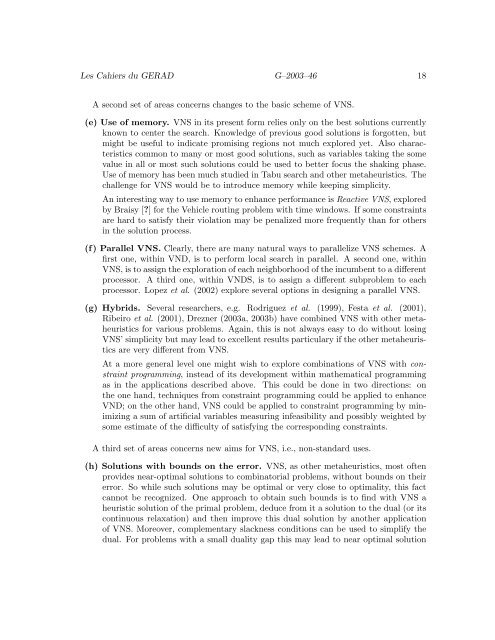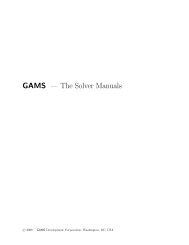A Tutorial on Variable Neighborhood Search
A Tutorial on Variable Neighborhood Search
A Tutorial on Variable Neighborhood Search
Create successful ePaper yourself
Turn your PDF publications into a flip-book with our unique Google optimized e-Paper software.
Les Cahiers du GERAD G–2003–46 18<br />
A sec<strong>on</strong>d set of areas c<strong>on</strong>cerns changes to the basic scheme of VNS.<br />
(e) Use of memory. VNS in its present form relies <strong>on</strong>ly <strong>on</strong> the best soluti<strong>on</strong>s currently<br />
known to center the search. Knowledge of previous good soluti<strong>on</strong>s is forgotten, but<br />
might be useful to indicate promising regi<strong>on</strong>s not much explored yet. Also characteristics<br />
comm<strong>on</strong> to many or most good soluti<strong>on</strong>s, such as variables taking the some<br />
value in all or most such soluti<strong>on</strong>s could be used to better focus the shaking phase.<br />
Use of memory has been much studied in Tabu search and other metaheuristics. The<br />
challenge for VNS would be to introduce memory while keeping simplicity.<br />
An interesting way to use memory to enhance performance is Reactive VNS, explored<br />
by Braisy [] for the Vehicle routing problem with time windows. If some c<strong>on</strong>straints<br />
are hard to satisfy their violati<strong>on</strong> may be penalized more frequently than for others<br />
in the soluti<strong>on</strong> process.<br />
(f) Parallel VNS. Clearly, there are many natural ways to parallelize VNS schemes. A<br />
first <strong>on</strong>e, within VND, is to perform local search in parallel. A sec<strong>on</strong>d <strong>on</strong>e, within<br />
VNS, is to assign the explorati<strong>on</strong> of each neighborhood of the incumbent to a different<br />
processor. A third <strong>on</strong>e, within VNDS, is to assign a different subproblem to each<br />
processor. Lopez et al. (2002) explore several opti<strong>on</strong>s in designing a parallel VNS.<br />
(g) Hybrids. Several researchers, e.g. Rodriguez et al. (1999), Festa et al. (2001),<br />
Ribeiro et al. (2001), Drezner (2003a, 2003b) have combined VNS with other metaheuristics<br />
for various problems. Again, this is not always easy to do without losing<br />
VNS’ simplicity but may lead to excellent results particulary if the other metaheuristics<br />
are very different from VNS.<br />
At a more general level <strong>on</strong>e might wish to explore combinati<strong>on</strong>s of VNS with c<strong>on</strong>straint<br />
programming, instead of its development within mathematical programming<br />
as in the applicati<strong>on</strong>s described above. This could be d<strong>on</strong>e in two directi<strong>on</strong>s: <strong>on</strong><br />
the <strong>on</strong>e hand, techniques from c<strong>on</strong>straint programming could be applied to enhance<br />
VND; <strong>on</strong> the other hand, VNS could be applied to c<strong>on</strong>straint programming by minimizing<br />
a sum of artificial variables measuring infeasibility and possibly weighted by<br />
some estimate of the difficulty of satisfying the corresp<strong>on</strong>ding c<strong>on</strong>straints.<br />
A third set of areas c<strong>on</strong>cerns new aims for VNS, i.e., n<strong>on</strong>-standard uses.<br />
(h) Soluti<strong>on</strong>s with bounds <strong>on</strong> the error. VNS, as other metaheuristics, most often<br />
provides near-optimal soluti<strong>on</strong>s to combinatorial problems, without bounds <strong>on</strong> their<br />
error. So while such soluti<strong>on</strong>s may be optimal or very close to optimality, this fact<br />
cannot be recognized. One approach to obtain such bounds is to find with VNS a<br />
heuristic soluti<strong>on</strong> of the primal problem, deduce from it a soluti<strong>on</strong> to the dual (or its<br />
c<strong>on</strong>tinuous relaxati<strong>on</strong>) and then improve this dual soluti<strong>on</strong> by another applicati<strong>on</strong><br />
of VNS. Moreover, complementary slackness c<strong>on</strong>diti<strong>on</strong>s can be used to simplify the<br />
dual. For problems with a small duality gap this may lead to near optimal soluti<strong>on</strong>
















